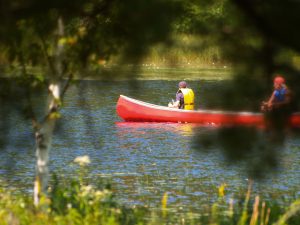
1974 BARNUM was RIGHT
In the many summers I have been in the woods I have seen a lot of changes in the way people travel on camping trips. And, too, I have noticed a lot of changes in people. In the days when camping was at its peak, and I still think that Algonquin Park was then just about the finest area ever created for such activities, travelling and equipment were pretty much standard. Tents were simply all canvas. The new treatment to make these tents waterproof was just coming into vogue (I am talking about the years during and following the first world war) though few would use a tent so treated, as the colour was not nice, and did not make for good sleeping. Water transportation was by canoe, and if some of the campers of those years could see the way canoes are being handled today they would do more than raise an eyebrow. Since any canoe trip, even one of only a day or two, required being on more than one lake or river, it meant a lot of carrying. The portages then, while mostly kept open, were not as well kept as the trails today. A canoe trip of any length meant three trips over each portage, especially at the start. Towards the end of the trip, with most of the food gone, packs got lighter. Most, if not all, the equipment was carried in pack sacks and had shoulder straps, also a head strap. The dunnage bags, sometimes three at a time, were mostly carried with a tump line. This is along strap, with a head piece in the middle. Straps were tied around the bags, and the head strap placed on top of the head. Years ago men who worked at carrying were able to carry very heavy loads on these straps. Many of the older guides of those days, especially the Indians, also used a tump line for carrying canoes, this strap placed so as to come between the paddles and over the top of the head. Since I have used such a method for many years, I can say it makes a canoe much easier to carry. But in any case the tump strap goes over the head, not the forehead.
Shortly after that first war I saw the first of many canoe-carrying yokes. One firm even made canoes with the yoke for the centre thwart, and predicted that in a few years everyone would be using them. There are still a few around, but the idea never really caught on. I tried such a method a few times, and each time I thought less of the idea. I stick to the paddles and the tump line.
I think the next thing to revolutionize camping was a sort of cart that you could load your canoe and packs on and pull it over the trail to the next lake or river. The man who came up with the idea had never been on many of the Park trails. This cart was made of aluminum, well built, with two over-sized bicycle wheels. Like a lot of things, the theory was fine, but while I know of several that were taken to the woods, I do not know of any that made the second trip. A lot of them were sold, but I have not seen one in years.
The latest fad is the pack board, also made of aluminum, light and strong, good shoulder straps, but no head strap or tump line. These are made quite long, and users tell me that is so some of the load can rest on your hips. There are several straps with which to fasten bed rolls, etc., on said board. People who have used them think they fill the bill. But they are far too long to fit in the carry space in a canoe. Especially since users tie on so many small parcels. I saw a party with these boards last week, and one chap had more things hanging on his pack board than you see on some Xmas trees. But they had their trip, carried their belongings that way, and were quite pleased with them, so maybe I am the one who is wrong. Still think the best equipment is the old fashioned pack sack.
Years ago there appeared a number of pack baskets. These had shoulder straps as well as head straps. They did not rest as well on your back as a softer pack, but they were handy for carrying lunch or something you had to get at quickly. Still have one, but never use it.